Coat of arms and flag of Russia. What does the flag of Russia mean? Coat of arms of Russia - photo
The state emblem and flag of Russia are legally established and secured by the Federal Constitutional Laws of the Russian Federation No. 2 FKZ and No. 1 FKZ on December 25, 2000, signed by President Putin V.V. But even before that they were approved by the executive branch: 08/22/1991 by the Extraordinary Commission of the Supreme Council The RSFSR adopted the white-blue-red tricolor as the flag of Russia. On November 30, 1993, by the Presidential Decree of Russia, its historical coat of arms, the double-headed eagle, was returned.
It entered the new with historically restored and legalized traditional state symbols ... They unite the nation, and express fidelity to historical tradition. Meanwhile, their appearance is strictly regulated and detailed in the aforementioned laws.
Russian symbols of sovereignty: coat of arms and flag
The way the coat of arms and the flag of Russia look like is described in detail in the first articles of the aforementioned constitutional laws. The sovereign coat of arms is represented by a red heraldic quadrangular shield, the lower edges of which are rounded, and the center is pointed downwards. The shield depicts a golden double-headed eagle spreading its wings. Each of his heads is surmounted by a small crown, and above them is a large crown connected to smaller ribbons. The royal Russian eagle has a scepter and an orb. The shield on his chest is decorated with the image of a silver horseman (George the Victorious), striking a dragon trampled by a horse with a spear.
The flag of Russia is represented by a rectangular panel (the ratio of height to width is two to three), consisting of three horizontal stripes of equal size. Their order (by color): white, blue, red.
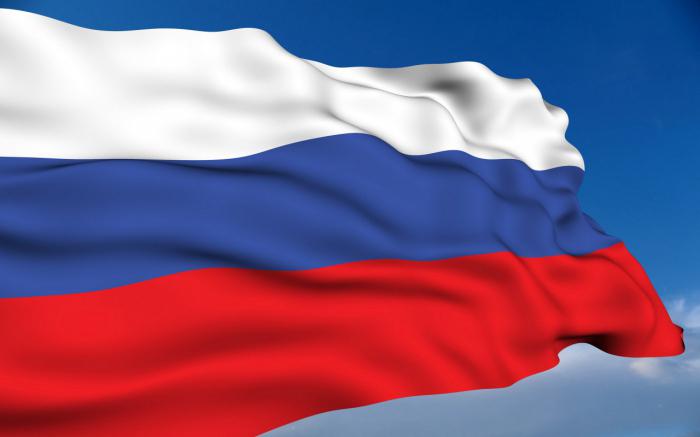
Regulation of the use of the emblem and flag of Russia
Legislation officially defines the scope of use of the emblem and flag of Russia. They are placed on the buildings of the Supreme State power: the residence of the President of the Russian Federation, the Federation Council, the State Duma, the courts - the Constitutional, Supreme, Supreme Arbitration. The coat of arms and the flag of Russia are also used in a wide network of state institutions throughout Russia, including law enforcement agencies. On public holidays, the right to decorate their homes with flags is granted to the inhabitants of Russia.
Three (coat of arms, flag, anthem) are a kind of triad that has developed by the end of the 19th century. The process of creating the State Emblem can be called the most historically capacious. Of course, the symbolism of Russia was created in different eras, each of which left its mark. So, the inscription of the elements of our coat of arms was found in antiquity (which we will talk about a little later). You can also talk about the ancient Russian creative process of creating the State Flag, which took place in the Middle Ages. Spontaneously, among the many colors, those were chosen that testified to belonging to Rus', from the many graphic elements, those that "clung to the soul" of a Russian person were sought out.
The heraldic images of the double-headed eagle, which served as the basis for its creation, appeared in the Middle Ages.
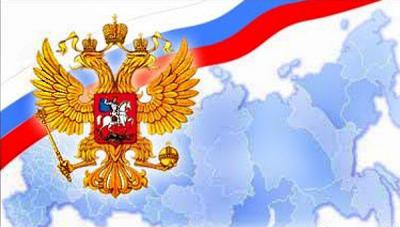
Double-headed eagle. The coat of arms of Russia is a product of an ancient ethnic group
Where did the double-headed eagle come from, where does the coat of arms of Russia originate? What does he mean? The answer to these questions can be given, perhaps, only by History. Even from Plato, a tradition allegedly inherent in the Atlanteans went, to associate wings with divinity. The eagle was interpreted by many ancient ethnic groups as a symbol of immortality, strength and fearlessness. The double-headed eagle symbolizes double wisdom, omniscience, perfection.
The idea of creating a symbol in the form of the aforementioned bird originated on the territory of Asia Minor, 2-3 thousand years BC. e. By the XIII century BC. e. include a rock image of a double-headed eagle created by the Hittites.
Double-headed eagle in ancient Rus'
In 1472, after the conclusion of the royal marriage of John III Vasilyevich with the niece of the last emperor of Byzantium, Constantine Palaiologos XII, Sophia Palaiologos, the Russian tsar received the right to use the image of a double-headed crowned eagle as his family emblem. In fact, the monarchical Moscow government becomes the successor of the head of the Orthodox East, the Byzantine emperor.
Since then, the double-headed eagle has appeared on the seals of the Russian Tsar, symbolizing the highest state power.
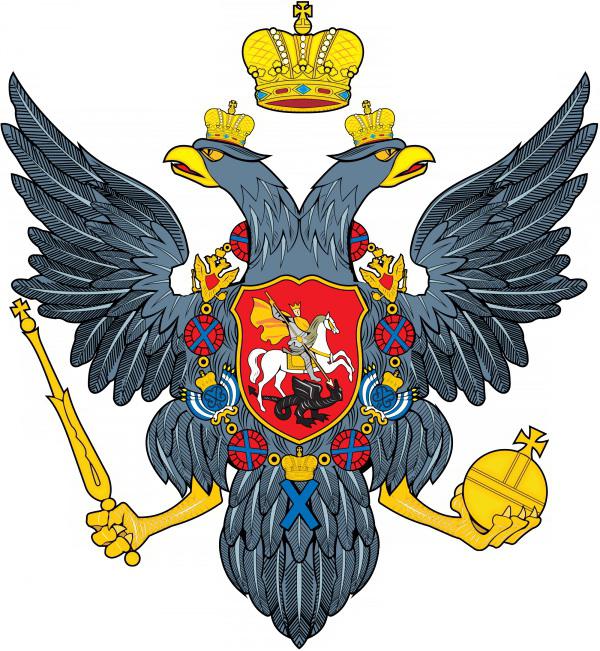
It still had little resemblance to the modern coat of arms of Russia: the wings are lowered, the feathers are not fluffed, the beaks are closed, the eagle has no shield. After liberation from the Tatar-Mongol yoke, under Tsar John III, the wings of the eagle rise. The coat of arms adorns public buildings.
After the transfer of power to his son, Vasily III, the eagle's beaks open. This small detail is associated with the fact that Russia has become the center of Orthodoxy and the growth of its state power. In the XIV century, during the reign of John IV the Terrible (son of Vasily III), both Russian symbols - the double-headed eagle and the horseman slaying the dragon - finally merged. The presence of George the Victorious was explained by the annexation of the Astrakhan and Kazan kingdoms and Siberia to Russia.
As you can see, heraldry is gradually developing, literally drawing the State Emblem of Russia over the centuries. With the coming to power of Mikhail Fedorovich Romanov (1613), which marked social stability and prosperity, a third crown appears - a symbol of the Holy Trinity. The heraldic eagle spread its wings picturesquely. Explanation for the latter: the Russian Tsardom became a single state association.
Alexei Mikhailovich in 1667 legitimizes the existing state emblem. Under him, a scepter and an orb appeared in the paws of a royal bird, which symbolized the absolute establishment of a monarchical system in Rus'.
From Peter I to Nicholas I
Since 1682, Russia was ruled by a highly educated and active man, the great reformer and autocrat Peter the Great. Under him, the double-headed eagle turned from gold to black (which corresponded to heraldic rules). On October 22, 1721, he took the title of emperor (before him, Russia was ruled by tsars). This also affected the coat of arms: the crowns became imperial (instead of royal). The unfolded wings of an eagle adorn shields with the coats of arms of the Kingdoms and Grand Duchies. Peter I connects the three crowns with a blue St. Andrew's ribbon.
During the short reign of Paul I (from 1796 to 1901), a large coat of arms of Russia appeared (photo attached). The sovereign crowned the royal bird with the Order of Malta, but this innovation did not take root. The efforts of Alexander I to smooth the feathers, to tilt their heads asymmetrically, to replace the scepter and orb with thunderbolts and lightning did not take root.
The tough and domineering emperor Nicholas I returned the coat of arms to the classic features introduced by Peter the Great. The coat of arms of Russia (photo below) becomes again laconic, heraldically verified and strict. The black two-headed bird with outstretched wings has acquired classic features.
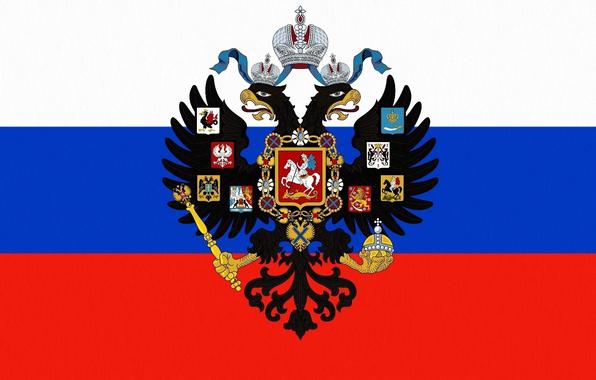
Regression of state heraldry
The collapse of the empire and the entire social structure had a regressive effect on state heraldry. Attempts by the Provisional Government to deprive the double-headed eagle of royal regalia were unsuccessful. Then the Bolsheviks changed the historical Russian coat of arms to their own, non-national one. History does not forgive such liberties, and 83 years later puts the dot over i... We are talking about the return of historical state symbols by the aforementioned presidential decrees and Constitutional Laws. Below we will discuss what the eagle on the coat of arms of Russia means after all.
Some features of the current coat of arms of Russia
What does the modern State Emblem of Russia mean from the standpoint of heraldry? The modern interpretation of two-headedness: the unity of conservatism and progress. The structure of the wings is symbolic: 12 flight feathers on each of them also display the equality of the subjects of the Federation. 3 rows of feathers embody Goodness, Truth and Beauty. The red shield is associated with courage, heroism, Russian historical tradition, the golden color of the eagle is associated with dignity, glory and eternity. The scepter is a symbol of sovereignty, power - power and integrity. The three crowns are now interpreted, in the secular sense, as the unity of the legislative, executive and judicial powers.
Such is it, ancient and modern, the majestic coat of arms of Russia, holistic in its content and deep in the historical tradition embodied in it, a symbol of a great power.
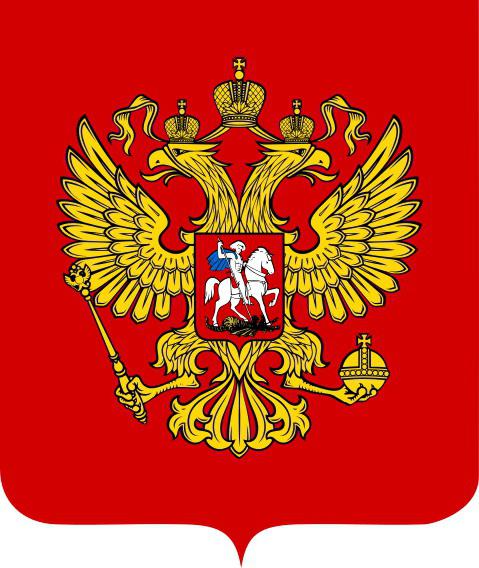
We also recommend paying attention to some interesting details of the coat of arms. Firstly, on the scepter, squeezing the eagle's right paw: it also has an eagle squeezing the same scepter, etc. By the way, the current coat of arms violates heraldic canons: according to them, St. George the Victorious should ride a horse not to the right, but to left side.
Modern coins actually decorate (without the attributes of the monarchy), and not the current coat of arms of Russia.
Colors of Russian banners, prototypes of the State Flag
It is noteworthy that in the Middle Ages, at a time when the Russian nation was just being formed, a single flag did not yet exist, but there were different banners. The historical Russian tradition deserves attention: banners used the colors of the Russian flag even then. "The Tale of Igor's Campaign" speaks of red Russian banners with the faces of saints embroidered on them. Red banners were crowned with the squads of the Prophetic Oleg, storming the heart of Byzantium - Constantinople, as well as the squads of Prince Svyatoslav, with which the Khazars were defeated.
For the first time, it was the red flag with the face of Christ that united Rus', flying over a mighty army led by Dmitry Donskoy on the Kulikovo field. Under the image of the Archangel Michael, Dmitry Pozharsky raised an uprising. White, blue and red colors were present on the "great banner" of Ivan the Terrible. Yermak conquered Siberia under a white and blue cloth.
Only in the 17th century was a flag created that adorned the coat of arms of Russia. What does this evolution mean? Gradual awareness by the Russian people of the historical mission of their state.
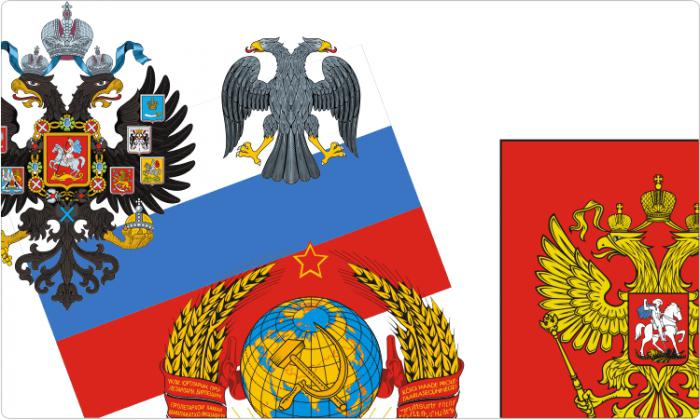
The creator of the Russian flag - Peter I
It is gratifying that the first State Flag of Russia, which flew on 08/06/1693 over the twelve-gun yacht "Peter the Great", on which the emperor sailed in the White Sea, has been preserved to this day in the St. Petersburg Museum of the Navy. This flag is 4.6 meters wide and 4.3 meters long.
How did this standard come about? On the eve of the sovereign, the Dutch engineer Butler, who led the construction of the aforementioned yacht, was simply discouraged by an unexpected question. He asked (and the wave is reasonable), launching the ship into the water, about which flag the king would like to raise. “Really, which one?” - obviously, Peter I thought to himself. And he asked Butler about the Dutch flag. He willingly spoke about his national three-striped red-white-blue cloth.
Did Peter I think what the State flag of Russia should become before this conversation? Hardly. The Dutchman's question came at the right time. The sovereign was not interested in creativity. He not only changed the heard order of the flag stripes (white, blue, red), but also placed a coat of arms on it - a golden double-headed eagle. So there was a single banner for the entire Russian fleet.
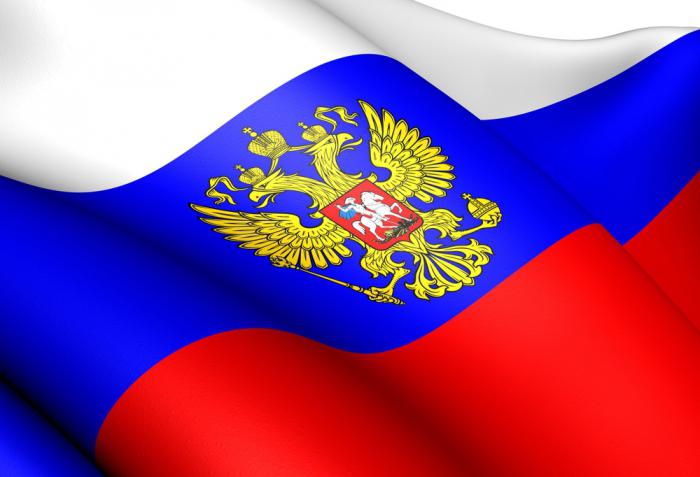
Its state establishment is evidenced by the fact that a year after the first presentation, in 1664, at the behest of Emperor Peter I, it was raised above the 44-gun frigate "Holy Prophecy" bought from Holland. In 1696, the Russian rowing squadron participating in the siege of the Turkish fortress of Azov also operated under the tricolor flag (as can be seen from Shkhonebek's engraving "The Capture of Azov"). There are various handwritten instructions of Peter the Great, indicating that the tricolor flag in the fleet was introduced by the tsar centrally and systematically.
However, after twenty-five years in the navy, it was replaced by the St. Andrew's flag (paradoxically, it was also the idea of Peter the Great). However, the idea of a three-color banner also proved to be viable, people liked it. In 1806, the familiar colors were revived on a trading company, they were also officially used by the Consul General of Russia. The attempt, made under Tsar Alexander II, to choose a white-yellow-black color scheme for the flag of Russia was not accepted by the people. Emperor Alexander III, evaluating the relevant study of the commission of K. N. Posyet, did a wise deed - he legalized the flag of Peter, which has a two-hundred-year history, as the All-Russian state flag.
Note that even today there is no official explanation of what the flag of Russia means. I wish there was such an interpretation.
Informal interpretation of the colors of the flag
The traditionally established heraldic interpretation of colors is as follows: white denotes frankness and nobility; blue - honesty, loyalty, sincerity; red - service, generosity, courage.
In Tsarist Russia, it was believed that white is a symbol of the Orthodox faith, blue - royal power, red - the Russian people. This corresponded to the declarative triune principle of the structure of the Russian state: autocracy, Orthodoxy, nationality.
Currently, there are several interpretations: the unity of the legislative, executive and judicial powers; unity of past, present and future.
We all know what the modern flag of Russia looks like (the photo of this element of state symbols must be familiar to everyone without exception). But why use these particular tones? We will make a reservation right away that the legislation does not establish the selection of shades of white, blue and red. However, they are fixed by GOST R 51130-98. According to him, each color must correspond to a shade that is displayed in three different international systems (meaning Pantone, RGB, HTML) as follows:
- - white (White; 255-255-255; #FFFFFF);
- - blue (286C; 0-57-166; #0039A6);
- - red (485C; 213-43-30; #D52B1E).
This color scheme emphasizes the freshness and grandeur of the Russian flag.
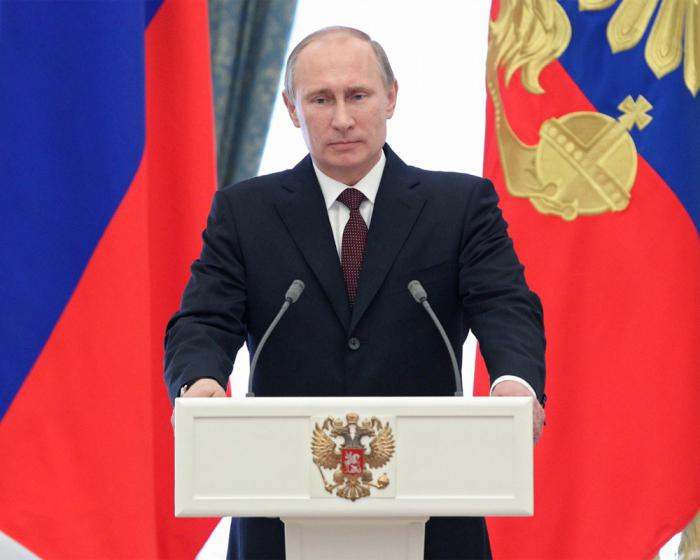
Conclusion
The coat of arms and the flag of Russia are close to the hearts of Russians who are truly proud of the history of their homeland. These sovereign symbols can be seen not only over state institutions and in the offices of officials.
The coat of arms and the flag of the Russian Federation are perceived and adequately positioned in the modern world. They carry a great charge of patriotism and pride, expressing the greatness of the country and its power. For more than four and a half hundred years they have been preserving and uniting a great power.




